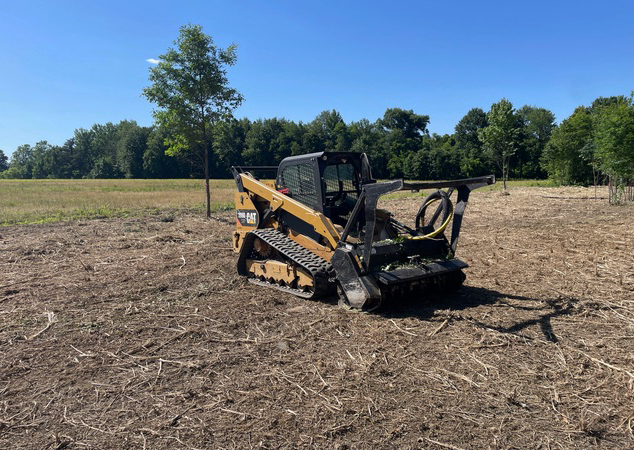Brush and Vegetation Control
 Forestry mulching is a land-clearing method that uses a single machine to cut, grind, and clear vegetation, including trees, brush, and stumps. The machine used for this purpose is typically a mulching machine or forestry mulcher, which is equipped with a rotary drum outfitted with steel chipper tools or carbide teeth.
Forestry mulching is a land-clearing method that uses a single machine to cut, grind, and clear vegetation, including trees, brush, and stumps. The machine used for this purpose is typically a mulching machine or forestry mulcher, which is equipped with a rotary drum outfitted with steel chipper tools or carbide teeth.
A forestry mulcher/grinder is used to manage areas with dense brush and vegetation, control undesirable saplings, and clear trees up to 8-10 inches in diameter. It helps reclaim land from invasive species, especially in areas difficult to clear by hand or with other equipment, such as hillsides, paths, fence lines, and waterways. It's useful for selective thinning, land clearing, hunting and recreational properties, residential lots, commercial properties, and government projects. It's also employed for right-of-way clearing and maintenance for railways and utilities like electric, water, and gas.
Key Components and Process
- Forestry Mulcher: The primary machine used in forestry mulching. It can be mounted on a variety of base machines, including skid steers, excavators, or dedicated mulching machines.
- Mulching Head: The rotary drum with chipper tools or teeth that shred vegetation into mulch.
- Operation: The mulching machine is driven over the vegetation. The mulching head cuts and grinds the vegetation, reducing it to mulch, which is left on the ground as an organic layer.
Benefits
- Efficiency: Combines multiple steps (cutting, grinding, clearing) into one operation.
- Soil Protection: Leaves a layer of mulch that can help protect the soil from erosion and promote moisture retention.
- Versatility: Effective on various types of vegetation, including trees, brush, and vines.
- Reduced Waste: Mulch produced can decompose naturally, enriching the soil.
Applications
- Land Clearing: Preparing sites for construction, agriculture, or other land development.
- Right-of-Way Maintenance: Clearing and maintaining areas around utility lines, pipelines, and roadways.
- Habitat Restoration: Managing invasive species and promoting the growth of desirable and native plants.
Considerations
- Terrain: Best suited for relatively accessible and moderately rough terrain.
- Vegetation Density: Effective for moderate to dense vegetation; very large trees may require additional equipment.
- Environmental Impact: Minimal compared to traditional clearing methods, but care must be taken to avoid damage to desirable plants and habitats.


